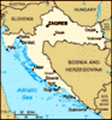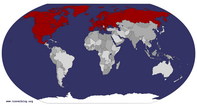Advertisement
Published: December 8th 2008
Read this article on EuropeUpClose at http://www.europeupclose.com/in-search-of-croatia%!e(MISSING)2%99s-first-wine-hotel/ The bus driver pulled over on the side of a long road. We hadn’t passed anything that looked alive in the past fifteen minutes. I could see nothing but empty vineyards and empty houses ahead. He looked at me through the rear view mirror to tell me it was my stop. I bumped several unsuspecting Croatian ladies with my backpack as I exited the bus, and it pulled away. Outside, a cold drizzle was just starting to make the situation even less pleasant.
I was on my way to Croatia’s first wine hotel. It was located in Brodski Stupnik, a small town in the middle of Slavonia. In many books about the Balkans, authors have described their fabulous train journeys across this region in eastern Croatia, so I was excited to see the landscape for myself. But, I quickly realized that Slavonia isn’t the best place for a journey on foot, particularly if you are lost.
I had been told that once I arrived in Brodski Stupnik, the walk to the wine hotel was a 2-kilometre, uphill, long, but signposted walk, so I was prepared for that. I was not
prepared for no signposts. I stood alone on the side of the road, looking around and finding no clues as to the whereabouts of the wine hotel. Dusk was nearly upon me.
The houses were shuttered and the few humans that passed were children on bicycles, all of whom said ‘bok’ to me, probably wondering who the foreigner was. I decided my best move would be to walk back the way I had come, figuring, if nothing else, I would at least be heading back to civilization in the nearest city of Slavonski Brod.
I laughed a little, but mostly wanted to cry. A few times I stopped, looked around and nearly shouted: ‘Seriously, where is the café?’’ This was Croatia, café-capital of the world after all, where you usually can’t walk ten feet without coming across a cafe. I longed to see a red Karlovacko umbrella that I’d earlier taken for granted.
As I pondered which vineyard would be best to duck into and sleep for the night, I spotted a woman smoking a cigarette out her window. She looked like she didn’t have a great grasp of even the Croatian language but I desperately called
out to her: ‘Molim? Do you speak English?’’ She laughed.
The road didn’t always have a sidewalk but it didn’t matter because there were no cars. At one point, as I lumbered along, I was overtaken by two chickens probably wondering who the foreigner was.
Two hours later, halfway back to Slavonski Brod, I finally spotted a convenience store. I burst through the doors and stood for a moment with a big smile and the sound of applause in my head.
One of the employees said I was six kilometres from the hotel. It was impossible to get back there now without a car. ‘There is a sign near the bus stop, didn’t you see it?’, he asked. I bit my tongue.
I phoned the hotel and told the manager, Leon, that I was at some store across from some church on some road about six kilometres away. He knew exactly where I was and said he’d be right there to pick me up.
Neither of us said anything as we drove past the giant sign for the Hotel Zdjelarevic a few yards past the bus stop, (or any of the several other signs along the way.)
The Zdjelarevic Wine Hotel was the first of its kind in Croatia. Davor and Vesna Zdjelarevic ran the vineyard for several years before opening the restaurant and hotel five years ago. ‘Very often, in the beginning, we had guests visit our wine cellar,’ Davor explained. ‘There didn’t exist any restaurant so we had to cook for them. There are 30 to 50 wine producers in Slavonia and many possibilities to take wine tastings but no possibilities to sleep. We travelled to wine regions in Italy and Austria and found that wine tourism is very popular because when people visit cellars they look to take some food and go to sleep.’
I, for one, had never been happier as I considered the prospect of having good food and wine and going to sleep. Two hours after arriving at the hotel, my toes had thawed and I had taken a long shower. I hand-washed my pants and put on the cleanest sweater in my backpack. There was a television in my room with more channels than I knew what to do with. Plushy blankets… music…warmth…what could be better?
The hotel has 15 rooms; singles, doubles and apartments. My room looked out on the vineyards where I could see a walking-tour gathering to explore the vineyards.
At 8pm, I was sitting comfortably with the evening’s first glass of wine. The hotel restaurant was decorated in autumn colours: orange and yellow gourds, green plants and red brick walls. Clanks and crashes from the open kitchen mingled with the soft sounds of glasses tinkling. Outside the picture windows were the long vineyards where flowers in all shades of pink blossomed.
‘Be careful,’ the waiter said, picking up my purse from the floor. ‘In Croatia, people say if your bag is on the floor, you don’t have any money.’ He set my purse on top of a black wine barrel beside me and the meal began.
I had pork medallions in wine sauce, boiled potatoes and a mixed salad. It was the best meal I’d had in ages. The waiter suggested three wines and I didn’t ask how much they were, I just told him to bring them on. First a white, then a red, and then a rosé. After he cleared my final plate, he asked if I wanted dessert. ‘No way,’ I said. ‘I couldn’t possibly eat another bite.’
Five minutes later, he returned with a huge piece of cake, drizzled with chocolate sauce. ‘This is carob cake, with apple and biscuit,’ he said, pointing to the word carob on the menu when I thought he said carrot. ‘The carob is from the Dalmatian coast, the biscuit is from Zagreb, the apple is from Slavonia. All of Croatia is in this dessert!’
Later that evening, in a quiet part of the restaurant with a bottle of rosé between us, Davor explained the history of wine-making in the village between sips. It has existed there since the time of the Roman Empire. When the Ottoman Empire took over the village, all the vineyards were cut down because the Turks didn’t drink. The vineyards sprouted up again after the Turks left, in areas where there were churches.
Before the Second World War, most of the people who lived in Brodski Stupnik operated a vineyard. After the war, people moved out of the countryside and into the cities to work for big industries. ‘That’s when we lost some of our tradition,’ Davor said. ‘My parents went from this place in 1958, and I was born in Zagreb. But I was connected with my grandfather and his property here and I got some feeling for this kind of life. My parents had their own jobs in the city but I decided that I wanted to keep the property and the tradition alive, so I came back to live.’
He said during the nearly 50 years that the Communist party ruled Croatia, private industry was discouraged and wine-making was restricted to a number of big state wineries. ‘In that time, state wineries made bad quality wine,’ Davor said. ‘It was pasteurized, like cooked wine. When we started, we did it beneath the law and we successfully sold it because we were the only private producers on the market. Ours were completely different than what people were used to.’
During the war in the 1990s, while other Slavonian cities were being bombed and the Slavonski Brod area alone lost 800 hectares of vineyards, Davor and Vesna were able to protect their property. ‘In this village there wasn’t much activity, not directly.’ Vesna said. ‘But it was hard for us because we had to travel to Zagreb, so we had to be careful.’
They taught me how to smell wine, how to taste it, and how to hold the glass so that it made a perfect clink during a cheers, or a jivjeli as it’s called in Croatia. Davor told me that zinfandel, long considered an American wine, was recently discovered to be the clone of a Croatian grape.
Croatia is small, but it has many differences. Istria and Dalmatia are in a better position to make wine, but, just like tourism, winemaking in Slavonia is only beginning.
Slavonia can be a difficult place to visit. Cities like Osijek or Vukovar, badly damaged during the war, provide sombre reminders of what happened not so long ago in this beautiful country. It’s so fresh that there are still holes in the buildings and you’ll rarely have a conversation with a local before they bring up the war.
But the wine hotel is a lovely example of the Croatian people’s recovery, their endurance and how far they have come. The countryside that was once known for its war is now becoming known for its wine.
I could easily have spent several days at the hotel, enjoying the organized horseback riding tours, wine tastings, or excursions to other vineyards. Even though it’s in the middle of nowhere, the Zdjelarevics make sure there are enough activities to keep their guests entertained. And I only paid 75 kuna (150 CAD) for my most luxurious night’s sleep in a week, including dinner and wine.
But I left after only one night, because I still had a two-kilometre, downhill walk back to the bus. And the more time I spent there, relaxing and eating and drinking to my heart’s content, the harder I knew it would be to leave.
Advertisement
Tot: 0.319s; Tpl: 0.013s; cc: 9; qc: 53; dbt: 0.051s; 1; m:domysql w:travelblog (10.17.0.13); sld: 1;
; mem: 1.2mb









